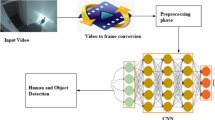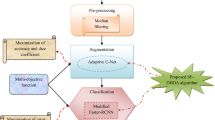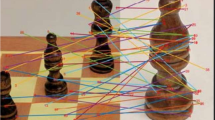Abstract
In visual classification, understanding among humans and objects is one of the main problems. Human object detection struggles to detect the human as well as object during complex interactions among them. In literature, some of the methods are presented to detect the human and object based on coarse spatial information and appearance features but they fail in complex situations. Hence, in this paper, Black Widow Optimization (BWO) based Deep Convolutional Neural Network (DCNN) Learning model is designed to identify the human as well as object from the video frames. The hyper parameters of the DCNN are optimally selected with the help of BWO algorithm. In the proposed methodology, pre-processing is used to enhance the image quality as well as removing noise from the images by using the gaussian filter and background subtraction. The human and objects are detected from the video frames with the help of DCNN, and performances are evaluated. The proposed method is implemented in MATLAB and statistical measurements are considered to evaluate the performance such as accuracy, sensitivity, precision, recall and F_Measure, respectively. The proposed method is compared with the existing methods such as Convolutional Neural Network (CNN), CNN-Emperor Penguin Optimization (EPO) and CNN-Particle Swarm Optimization (PSO), respectively.





Similar content being viewed by others
References
Zhang P, Liu W, Lei Y, Huchuan Lu (2019) Hyperfusion-net: hyper-densely reflective feature fusion for salient object detection. Pattern Recogn 93:521–533
Yazdi M, Bouwmans T (2018) New trends on moving object detection in video images captured by a moving camera: a survey. Comput Sci Rev 28:157–177
Ji Y, Zhang H, Wu QJ (2018) Salient object detection via multi-scale attention CNN. Neuro Computing 322:130–140
Kaur B, Sharma M, Mittal M, Verma A, Goyal LM, Jude Hemanth D (2018) An improved salient object detection algorithm combining background and foreground connectivity for brain image analysis. Comput Electr Eng 71:692–703
Nweke HF, Teh YW, Mujtaba G, Al-Garadi MA (2019) Data fusion and multiple classifier systems for human activity detection and health monitoring: review and open research directions. Inf Fusion 46:147–170
Huang X, Zhang Y (2018) Water flow driven salient object detection at 180 fps. Pattern Recogn 76:95–107
Fernando T, Denman S, Sridharan S, Fookes C (2018) Soft+hardwired attention: an lstm framework for human trajectory prediction and abnormal event detection. Neural Netw 108:466–478
Singha J, Roy A, Laskar RH (2018) Dynamic hand gesture recognition using vision-based approach for human—computer interaction. Neural Comput Appl 29(4):1129–1141
Tao P, Sun Z, Sun Z (2018) An improved intrusion detection algorithm based on GA and SVM. Ieee Access 6:13624–13631
Liu Li, Wang S, Guoxin Su, Huang Z-G, Liu M (2017) Towards complex activity recognition using a Bayesian network-based probabilistic generative framework. Pattern Recogn 68:295–309
Salman A, Siddiqui SA, Shafait F, Mian A, Shortis MR, Khurshid K, Ulges A, Schwanecke U (2020) Automatic fish detection in underwater videos by a deep neural network-based hybrid motion learning system. ICES J Mar Sci 77(4):1295–1307
Aquino G, Zacarias A, Rubio J, Pacheco J, Gutierrez G, Ochoa G, Balcazar R, Cruz D, Garcia E, Novoa J (2020) Novel nonlinear hypothesis for the delta parallel robot modeling. IEEE Access 8(1):46324–46334
Rubio J (2009) SOFMLS: online self-organizing fuzzy modified least-squares network. IEEE Trans Fuzzy Syst 17(6):1296–1309
Hassan MM, Alam MG, Uddin MZ, Huda S, Almogren A, Fortino G (2019) Human emotion recognition using deep belief network architecture. Inf Fusion 51:10–18
Chiang H, Chen M, Huang Y (2019) Wavelet-based eeg processing for epilepsy detection using fuzzy entropy and associative petri net. IEEE Access 7:103255–103262
de Rubio J (2020) Stability analysis of the modified levenberg-marquardt algorithm for the artificial neural network training. IEEE Trans Neural Netw Learn Syst. https://doi.org/10.1109/TNNLS.2020.3015200
Jing L, Zhao M, Li P, Xiaoqiang Xu (2017) A convolutional neural network based feature learning and fault diagnosis method for the condition monitoring of gearbox. Measurement 111:1–10
Meda-Campaña J (2018) On the estimation and control of nonlinear systems with parametric uncertainties and noisy outputs. IEEE Access 6:31968–31973
Hernández G, Zamora E, Sossa H, Téllez G, Furlán F (2020) Hybrid neural networks for big data classification. Neurocomputing 390:327–340
Singh D, Singh B (2020) Effective and efficient classification of gastrointestinal lesions: combining data preprocessing, feature weighting, and improved ant lion optimization. J Ambient Intell Humaniz Comput 95:1–16. https://doi.org/10.1007/s12652-020-02629-0
Agrawal S, Singh RK, Singh UP, Jain S (2019) Biogeography particle swarm optimization based counter propagation network for sketch based face recognition. Multimedia Tools and Applications 78(8):9801–9825
Zhijun Liang, Juan Rojas2†∗, Junfa Liu, Yisheng Guan (2020) Visual-semantic-pose graph mixture networks for human-object interaction detection. arXiv preprint arXiv:2001.02302
Matveev I, Karpov K, Chmielewski I, Siemens E, Yurchenko A (2020) Fast object detection using dimensional based features for public street environments. Smart Cities 3(1):93–111
Zhang J, Su H, Zou Wei, Gong X, Zhang Z, Shen F (2021) CADN: a weakly supervised learning-based category-aware object detection network for surface defect detection. Pattern Recognit 109:107571
Junwei W, Zhou W, Luo T, Yu L, Lei J (2021) Multiscale multilevel context and multimodal fusion for RGB-D salient object detection. Signal Process 178:107766
Li F, Jin W, Fan C, Zou L, Chen Q, Li X, Jiang H, Liu Y (2021) PSANet: pyramid splitting and aggregation network for 3D object detection in point cloud. Sensors 21(1):1–21
Elhoseny M (2020) Multi-object detection and tracking (MODT) machine learning model for real-time video surveillance systems. Circuits Syst Signal Process 39(2):611–630
Kim JH, Hong HG, Park KR (2017) Convolutional neural network-based human detection in nighttime images using visible light camera sensors. Sensors 17(5):1065
Alom MZ Hasan M Yakopcic C Taha TM Asari VK (2018) Recurrent residual convolutional neural network based on u-net (r2u-net) for medical image segmentation. arXiv preprint arXiv:1802.06955
Houssein EH, Helmy BE, Oliva D, Elngar AA, Shaban H (2021) A novel black widow optimization algorithm for multilevel thresholding image segmentation. Expert Syst Appl 167:114159
Mihailo M, Ćalasan M, Petrović DS, Ali ZM, Quynh NV, Aleem SH (2020) Field current waveform-based method for estimation of synchronous generator parameters using adaptive black widow optimization algorithm. IEEE Access 8:207537–207550
https://paperswithcode.com/sota/human-object-interaction-detection-on-hico
https://paperswithcode.com/sota/human-object-interaction-detection-on-v-coco
Shakya A, Biswas M, Pal M (2021) Parametric study of convolutional neural network based remote sensing image classification. Int J Remote Sens 42(7):2663–2685
Krishna KVSSR, Chaitanya K, Subhashini PPS, Yamparala R, Kanumalli SS (2021) Classification of glaucoma optical coherence tomography (OCT) images based on blood vessel identification using cnn and firefly optimization. Traitement du Signal 38(1):239–245
Author information
Authors and Affiliations
Corresponding author
Ethics declarations
Conflict of interest
The author declare that they have no conflict of interest.
Additional information
Publisher's Note
Springer Nature remains neutral with regard to jurisdictional claims in published maps and institutional affiliations.
Rights and permissions
About this article
Cite this article
Mukilan, P., Semunigus, W. Human object detection: An enhanced black widow optimization algorithm with deep convolution neural network. Neural Comput & Applic 33, 15831–15842 (2021). https://doi.org/10.1007/s00521-021-06203-3
Received:
Accepted:
Published:
Issue Date:
DOI: https://doi.org/10.1007/s00521-021-06203-3




